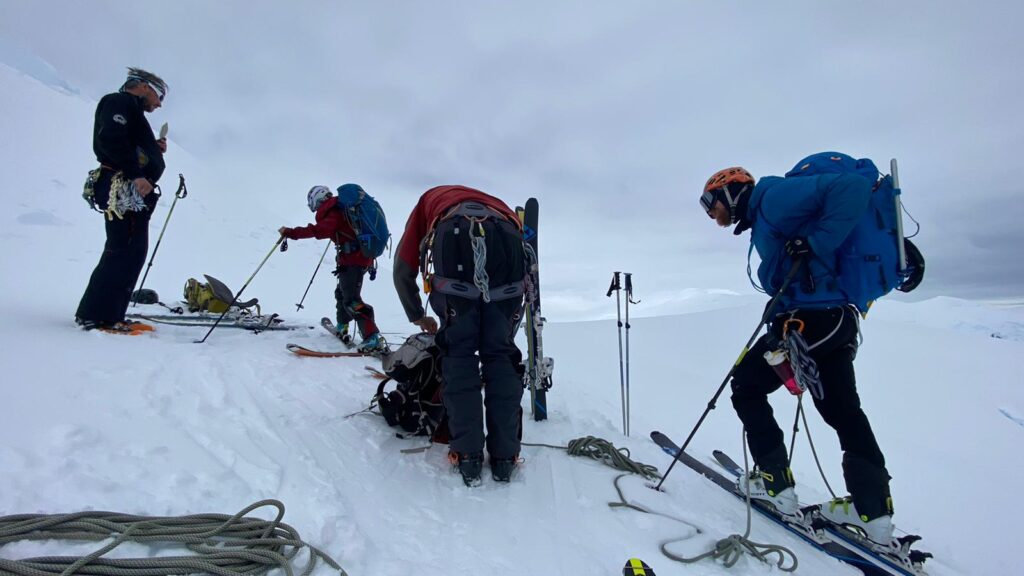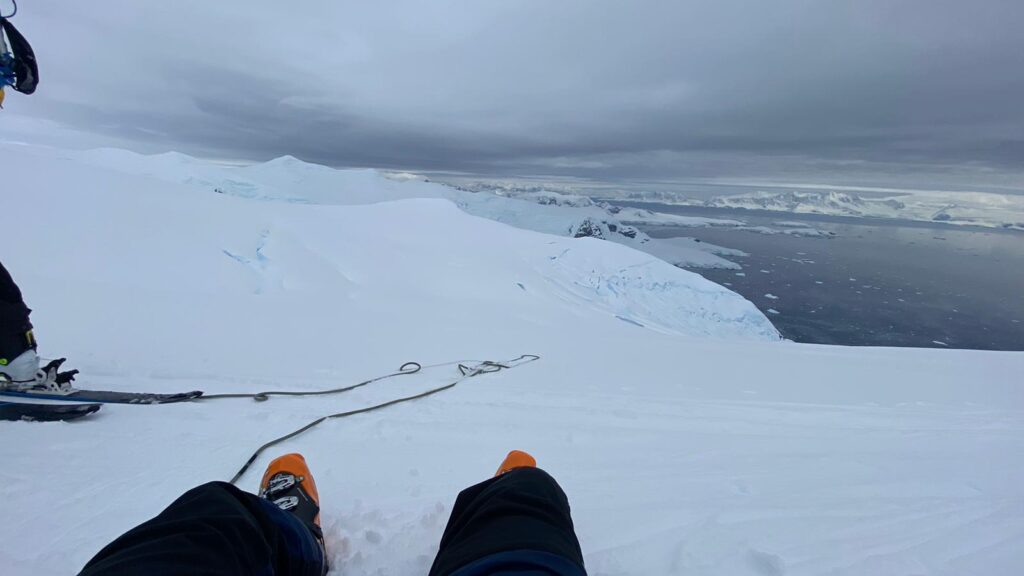After the whiteouts at the end of last week the team had mixed success over the weekend, with a good weather day on Saturday followed by a return to zero visibility on Sunday.
The progress of the expedition has been severely frustrated by the weather and snow conditions, from fierce storms to calm whiteouts keeping the team camp-bound, and heavy snowfall meaning the danger of seracs and avalanche risks have often prevented movement on good weather days.
Now the team have reached the point at which they know they can no longer afford to move their camp or equipment further inland if they want to be sure of safely returning to Portal Point in time for their pick up date. There are still 2 weeks left for the expedition, but this is as far as the team will move inland.
The team made the most of the good weather Saturday by getting as far inland as they could without their pulks in order to collect as much data as possible to support the scientific objectives of the expedition.
Here is the report from that day by Expedition Leader Paul Hart:
“Today we broke into a group of four and a group of three leaving one person to manage our camp. We departed camp at 10:30am with an intention to go as far forward as possible for taking further science samples but with a very strong emphasis on ensuring safety given the terrain and snow pack. Despite the significant risk of the slope of the terrain (which would have ended in a catastrophic fall into the glacier crevasse field leading into the sea) there were also other risk areas of potential serac and avalanche fall above the route.

“At start the snow pack conditions were good and enabled skis to cut into the snow, however, the objective danger of the route was such that there is no way sleds would have been suitable without there being a fixed rope system being set up for some 500-700m over the worst of the terrain. We negotiated this out for more than 2km as conditions continued to warm but then we came to a 38 degree slope that had significant snow movement on it and which increased to 45degrees. After doing a long and further assessment of the slope in what were becoming increasingly unstable conditions, we agreed that the potential for avalanche and also a fall was too great to accept. We retreated into platform at the entrance to an ice cave created by the outer ridge slope collapsing down into Charlotte Bay.
“After much discussion we agreed that we would move to higher ground to obtain samples for the science. Even as this was done the conditions of the temperature increased way above those predicted in the forecast and we began to become concerned about our route back. Given the conditions we decided to wait it out until cloud had closed down the sun and there was some drop in temperature. This took more than two hours but at that point we committed to our return route. We noted evidence of minor slides and debris across our path and do made the return journey as quickly and silently as possible. Fortunately we returned without mishap and it has to be said the soft snow conditions provided perfect skiing back down into camp.

“What is certain to all of us is thus crux point is not navigable hauling pulks without setting up a fixed line system. Nor is the descent onto Bailey Glacier possible except by lowering pulks on line as well. Beyond that point the route looked more achievable though there has clearly been massive change to the amount of snow both on the steepness of the ramp and also the route above camp three which is certainly equivalent to serious Alpine mountaineering standard with booted crampons. We are fortunate now to have no winds and sunshine so we are sat overlooking the waters towards Brabant Island. It’s a stunning evening but it’s to get short lived with weather coming in again overnight.
“It’s a shame that the heat presented such problems today but the decision to push forward without pulks was a wise one and allowed us to reach the farthest point for our science activity. We will aim to head to the Summit of Harris Peak Tomorrow if conditions allow.”
Conditions since that update have continued to frustrate the team’s objectives, but morale is still good and more importantly the team is still healthy and safe. Share your messages in the comments below, or on the various social media channels, and we’ll send them on to the team.
FOLLOW AND CONNECT WITH THE EXPEDITION ON SOCIAL MEDIA
Many thanks to all of our friends, sponsors and supporters who are backing the Antarctic Quest 21 expedition, including:
NAAFI Team Army/Team Ethos Costain Group PLC BetterYou Ltd Applied Satellite Technology LtdGreencastle Consulting Klättermusen AB Fjellpulken AS Polar Latitudes Clean Planet Energy PlanetLabs.Earth LikeToBe.org LGfL Devon and Plymouth Chamber of Commerce Royal Geographical Society Prof Dr Ger Graus OBE Phil Carrotte Tim Ellis Twin Science & Robotics Verofax Limited Alpenverein Osterreich Beyond Exploration Shackleton Whisky Paul Read Martin Holland, FRGS USNAR Polar Science and Technology Program The Ulysses Trust Expedition Base Camp Anjuli Selvakumaran Elliot Brown Watches University of Plymouth Utrecht University The University of Manchester Durham University University of Tasmania Challenging Habitat AndrewSmedley PippaWhitehouse Colonel Paul John Edwards MBE The Honourable Alexandra Shackleton Lieutenant General Richard Nugee CB CVO CBE AngelaMilne Simon Ussher Nigel Marley MichielvanDenBroeke ImogenNapper Emily Whitehead Kate Retallick Claire Grogan FRGS Charlotte Braungardt

“Dr Charlotte Braungardt is a freelance environmental scientist working through her consultancy Challenging Habitat. She is the scientific advisor for the Antarctic Quest 21 expedition.”